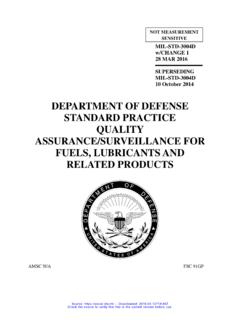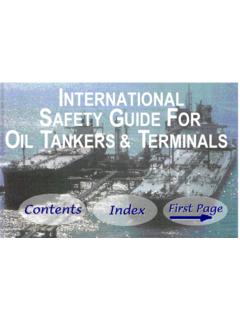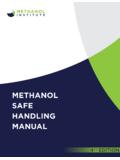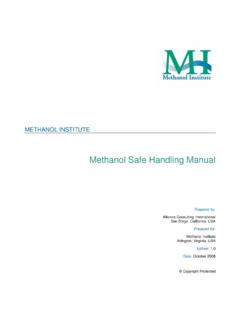Transcription of Bunkering Checklist Appendix II - Port Klang
1 Bunkering OPERATIONS (As Published in ISGOTT 5th Edition by ICS/OCIMF) Spillages and leakages during Bunkering operations are a primary source of oil pollution from ships. Experience has shown that many of the bunker overflows and spillages that do occur can be attributed to human error. This chapter provides guidance on the planning and execution of Bunkering operations and includes an example of a pre-transfer safety check-list. General All Bunkering operations should be carefully planned and executed in accordance with MARPOL regulations. Pollution caused when heavy fuel oil is split is particularly damaging and difficult to clean-up. Personnel involved in the Bunkering operation on board should have no other tasks and should remain at their workstations during topping-off.
2 This is particularly important when bunkers are being loaded concurrent with cargo operations, in order to avoid conflicts of interest for operational personnel. Spillages often occur when staff are distracted by another task. Bunkering Procedures Companies should require that all Bunkering operations are controlled under procedures that are incorporated in the ship s Safety Management System. The procedures should ensure that the risks associated with the operation have been assessed and that controls are in place to mitigate these risks. The procedures should also address contingency arrangements in the event of a spill. The Company should consider the following items when producing the procedures: Determining that there is adequate space for the volume of bunkers to be loaded.
3 Establishing maximum loading volume for all tanks. Controls for the setting of bunker system valves. Determining loading rates for the start of l oading, bulk loading and topping-off. Special precautions when loading into double bottom tanks. Arrangements of bunker tank ventilation. Internal tank overflow arrangements. Verification of gauging system operation and accuracy. Alarm settings on overfill alarm units. Communication with the terminal to establish when Bunkering can be undertaken. Appendix II Communications with the bunker supplier prior to commencement, to establish and record the loading procedure to be followed and to determine how quantity and quality checks may be carried out, particularly if safe access is needed between the ship and a bar ge. Methods of managing the handling of bunkers which have or may have a hydrogen sulphide (H2S) content.
4 Testing procedures for determining the presence of hydrocarbon or H2S vapours. Method of determining the temperature of t he bunkers during loading. Communications procedure for the operation, including emergency stop. Manning requirements to execute the operation safely. Monitoring of the Bunkering operation and checking it conforms to the agreed procedure. Changing over tanks during loading. Containment arrangements and c lean-up equipment to be available. Once the procedure is produced, i t should be implemented by use of a check-list, an example of which is included herewith. The Bunkering Operation Prior to commencing the operation, all pre-loading checks should be carried out and communication systems verified as working. The loading rate should be checked regularly. When changing over from one tank to another, care should be taken to ensure that an excessive back pressure is not put on the hose or loading lines.
5 When topping-off tanks, the loading rate should be decreased to reduce the possibility of air locks in the tank causing mist carry over through the vents, and to minimize the risk of the supplier not stopping quickly enough. On completion of loading, all hoses and lines should be drained to the tank or if applicable, back to the barge, prior to disconnection. The practice of blowing lines with air into bunker tanks is a common one, but has a high risk of causing a spillage unless the tank is only part full and has sufficient ullage on completion of loading. The Bunkering Safety Check-List General Responsibility and accountability for the safe conduct of operations while a ship is receiving bunkers by barge is shared jointly between the Masters of the receiving vessel and of the barge.
6 The responsibility for the Bunkering operation is usually delegated to designated Responsible Officers on the ship and on the barge. Before the Bunkering operation commences, the Responsible Officers should: Agree in writing on the handling procedures i ncluding the maximum transfer rates. Agree in writing on the action to be taken in the event of an emergency during transfer operations. Complete and sign the Bunkering Safety Check-List. The Bunkering Safety Check- List is based upon the Ship/Shore Safety Check-List and the Pre-Transfer Bunkering Check-List contained in the IMO publication Recommendations on the Safe Transport of Dangerous Cargoes and Related Activities in Port Areas . The Check-List is primarily structured for loading bunkers from a barge, but it is also suitable for use when taking bunkers from a jetty or when loading bulk lubricating oil or gas oil from a road tanker.
7 Guidelines for Use The following guidelines have been produced to assist ship, barge and terminal operators in their joint use of the Bunkering Safety Check-List. The Bunkering Safety Check-List uses statements assigning responsibility and accountability. Ticking or initialling the appropriate box, and finally signing the declaration, confirms the acceptance of obligations. Once signed, this provides the minimum basis for safe operations as agreed through a mutual exchange of critical information. Some of the Check-List statements are directed to considerations for which the ship has sole responsibility and accountability, some for which the barge has sole responsibility and accountability and others which assign joint responsibility and accountability. Shaded boxes are used to identify statements that generally may be applicable to only one party, although the ship or barge may tick or initial such sections if they so wish.
8 The assignment of responsibility and accountability does not mean that the other party is excluded from carrying out checks in order to confirm compliance. The assignment of responsibility and accountability ensures clear identification of the party responsible for initial and continued compliance throughout the transfer activity. The Responsible Officers completing the Check-List should be the people carrying out the Bunkering operation. The tanker s Responsible Officers should personally check all considerations lying within the responsibility of the tanker. Similarly, the barge s Responsible Officer should personally check all considerations that are within the responsibility of the barge. In fulfilling their responsibilities, Responsible Officers should assure themselves that the standards of safety on both sides of the operati on are fully acceptable.
9 This can be achieved by means such as: Confirming that a competent person has satisfactorily completed the Check-List. Sighting appropriate records. By joint inspection, where deemed appropr iate. For mutual safety, before the start of operations, and from time to time thereafter, a barge representative and a ship s officer should conduct inspections of the barge and the ship to ensure that their obligations, as accepted in the Check-List, are being effectively managed. The Bunkering Safety Check-List contains the following sections : 1. Bunkers to be Transferred: A joint agreement on the quantity and grades of bunkers to be transferred, together with agreed transfer rates and the maximum line back pressures. 2. Bunker Tanks to be loaded An identification of the tanks to be loaded with the aim of ensuring that there is sufficient space to safely accommodate the bunkers to be transferred.
10 Space is provided to record the each tank s maximum filling capacity and the available volume. 3. Checks by Barge Prior to Berthing This section provides the checks to be carried out before the barge goes alongside the ship. 4. Checks Prior to Transfer This section provides the checks to be jointly undertaken before transfer activities commence. The safety of operations requires that all relevant statements are considered and the associated responsibility and accountability for compliance accepted. Where either party is not prepared to accept an assigned accountability, a comment must be made in the Remarks column and due consideration given to whether operations should proceed. Where an item is agreed not to be not applicable to the ship, to the barge or to the operation envisaged, a note to that effect should be entered in the `Remarks column.






